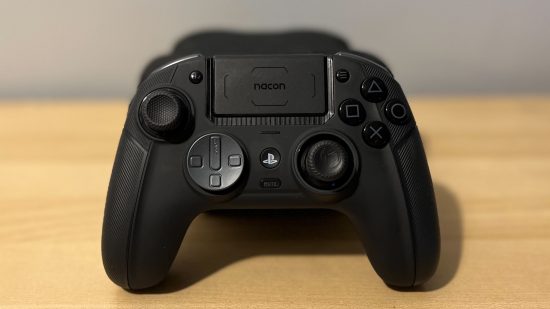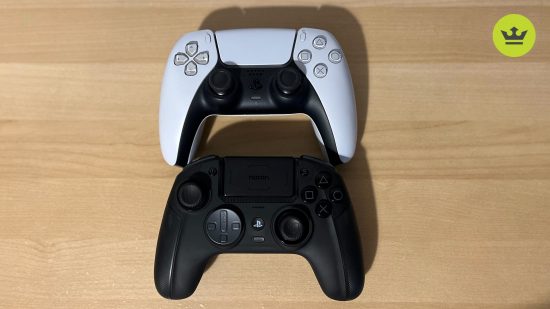Our Verdict
The Nacon Revolution 5 Pro is a comfortable and well-built controller and provides the high levels of customization you'd expect from a controller at its price point. However, its design choice when it comes to its extra back buttons won't be agreeable with everyone, and it can't support some of the PS5's key features.
- Comfortable shape and textured grips
- Customization and modularity
- Decent battery life
- Hall effect tech for durability
- Back button positioning
- Doesn't support PS5 DualSense features
There’s no denying that the standard PS5 DualSense is a great controller, but it doesn’t really cut the mustard when it comes to competitive gaming. Of course, Sony realizes this and offers up the DualSense Edge, but there are plenty of third-party alternatives to consider as well if you’re looking for an advanced, high-end controller. I’ve been hands-on with one of the latest for our Nacon Revolution 5 Pro review to see how this massively-customizable controller stacks up.
When it comes to the best PS5 controllers that are at a higher price point than the standard DualSense, there is a lot of competition – there’s the aforementioned DualSense Edge, plus models from the likes of Scuf and Razer. The key question I ask myself when using any advanced controller is ‘does it improve the experience of playing multiplayer games?’, and with the Revolution 5 Pro, the resounding answer is yes. However, there are definitely some drawbacks to consider as well.
Nacon Revolution 5 Pro specs
| Supported platforms | PS5, PS4, PC |
| Wired connectivity | Yes, USB-C cable |
| Wireless connectivity | Yes, via USB dongle |
| Audio connectivity | Headphone jack or Bluetooth |
| Battery life | ~10 hours |
| Customization options | Six controller weights (two 10g, two 14g, two 16g), alternative D-pad, four joystick rings, four joystick heads |
Nacon Revolution 5 Pro design
The first thing PS5 players will probably notice when looking at the Nacon Revolution 5 Pro is that it has an asymmetrical stick layout, similar to what you’d find on an Xbox controller. As someone who plays across both console platforms, this meant I had no issues at all with getting my hands used to the stick position, but it may be something that those who are more used to the symmetrical layout of the DualSense take a bit of time to adapt to.
The other standout design feature, that you don’t really see on rival controllers, is the Revolution 5 Pro’s rubberized grips. I was blown away by how comfortable and cool this textured rubber material felt while holding the controller. The size of the grips in general, which are much thicker and slightly shorter than the grips on a standard DualSense, also helped in the comfort department.
The controller’s buttons are mostly well-placed and designed. The bumpers and triggers – which are vital if you’re playing the best FPS games, especially – felt responsive and satisfying to use, and the equally-vital joysticks also felt smooth. The sticks also benefit from Hall effect technology, which should help improve their longevity and stave off the dreaded stick drift that plagues standard DualSense controllers.
However, there are two aspects to the Revolution 5 Pro’s layout and button design that I felt were a bit flawed. The first was the rounded D-pad that your console will come with out of the box. It was just way too clunky and wouldn’t register presses without extreme precision and a fair bit of force – in a game like Call of Duty Modern Warfare 3, where I was regularly trying to call in killstreaks using the D-pad, this was rather irritating. Luckily, a more traditional cross-shaped D-Pad is one of your customization options, so I recommend swapping to this almost straight away.
The biggest issue though is the back buttons. These additional buttons are one of the biggest benefits an advanced controller like this one brings, as they allow you to bind certain actions to them so you can perform them without moving your digits off of sticks or triggers. The last high-end controller I owned was a Scuf Impact, which had long, protruding paddle-like buttons running down the spine of the controller. Going from that to the Revolution 5 Pro, which has its four mappable back buttons located flush to the inside of the grips, has been a tricky adjustment.
It’s taken me a long time to get anywhere close to comfortable with them, and rather than a quick click of a paddle that you can rest your finger on all match, I’ve had to retrain my grip, to an extent, to ensure I’m always resting my fourth and fifth fingers on the back buttons. It is something you will eventually get used to, and it certainly doesn’t invalidate the benefit of having extra buttons in the first place. However, they just aren’t as effective or naturally-positioned as the ones you find on competitors.
All the modular components on the controller – which I’ll talk about in more depth soon – can be stripped off and changed without the use of tools. While this is great for swiftly switching parts around, my initial concern was that there wouldn’t be a tight, quality feel as a result. However, my concerns were unfounded. Despite my gripes with the design of some of the buttons, there’s no denying that this is a really well-built and solid piece of gear, even with all of those interchangeable parts.
The quality of all the additional bits you get with the Revolution 5 Pro, such as the wireless dongle, the Bluetooth transmitter, and even the braided charging cable, also look and feel well put together. The zip-up carry case you get also feels sturdy and protective, with enough room to securely house all of your extra components with space to spare.
Nacon Revolution 5 Pro customization
So, let’s dive into arguably the main reason you’d want to buy this kind of controller in the first place – adaptability and customization.
The Revolution 5 Pro has several tricks up its sleeve. It has switches behind both triggers that let you adjust the travel distance (although there are only two settings, and competitors like the DualSense Edge and the Victrix ProCon offer more). You can slide off panels on the back of the grips and add weights to the controller to make it feel heavier in your hands. As mentioned earlier, there are also two different variations of D-pad that you can interchange.
You can also customize your joysticks a lot. There are various sizes and designs of stick toppers that you can interchange, and there are metal rings that you can place over the stalks of the sticks to make them snap back to center quicker. I’ve personally been happy with the default feel of the sticks, so I really haven’t used these additions much myself, but for those that really love the best fighting games, I can imagine the rings in particular will make a huge difference for performing combos.

One ace that the Revolution 5 Pro does have up its sleeve is that it isn’t just the physical hardware you can customize. For those that want to set their controller up with the most exact specifications and extract the absolute most from it, Nacon’s app will let you tinker with the controller’s software too. This lets you adjust deadzones for joysticks and triggers, change the colors of the LED lights, pick from different audio profiles, and more.
I’ve been impressed by both the physical modularity of the Revolution 5 Pro and the software customization that’s on offer as well. It’s certainly one of the controller’s greatest strengths.
Nacon Revolution 5 Pro other features
There are a few other final things to touch upon with the Revolution 5 Pro.
Battery life is adequate for a controller that’s got so many bells and whistles. You’ll get around ten hours of wireless play from a full charge.
Audio can be delivered either through the controller’s headphone jack or via its Bluetooth 5.2 transmitter, which lets you pair up with any earbuds or wireless headsets that also support 5.2. As I own a wired headset, I haven’t actually tested the Bluetooth option myself and can’t comment on the quality, but it is a super compact and easy way to keep your whole setup wire-free.
One thing you absolutely need to remember (and this goes for any third-party PS5 controller) is that the Nacon Revolution 5 Pro does not support PS5-centric features like adaptive triggers and haptic feedback. Only first-party gear from Sony has this support, so if you’re hoping to also use your Revolution 5 Pro in action games or racing games where these features can really help with immersion, then you’d have to either switch back to a standard DualSense or just make do without them. Basically, if you want an advanced controller that can also still do all the current-gen backflips the PS5 offers, your only option is the DualSense Edge.
Nacon Revolution 5 Pro conclusion
Overall, the Revolution 5 Pro excels at many things, but has a couple of pain points that stop it from being truly excellent.
Customization is its greatest strength, giving you access to an impressive breadth of hardware and software tweaks that more hardcore competitive players will absolutely appreciate. It’s also extremely well-built, is very comfortable to hold, and also trumps competitors like the DualSense Edge when it comes to battery life and stick durability.
However, there’s no escaping those back buttons – after using the controller for well over 25 hours, I’m yet to fully adjust to their positioning. While they are a bit awkward, the Revolution 5 Pro is still a much better controller than a standard DualSense or basic third-party controller when it comes to competitive play, and the benefits of its design and modularity are definitely still felt.
While not Nacon’s fault at all, the lack of support for features like haptic feedback also need to be taken into consideration for those wanting to get fully-immersed in the best PS5 games.
Nacon Revolution 5 Pro alternatives
Sony DualSense Edge
Unsurprisingly, with how much we’ve namedropped it during this review, the DualSense Edge is the main challenger to the Revolution 5 Pro. Sony’s competitive controller has most (but admittedly, not all) the customization options as Nacon’s model, but it does have the added bonus of supporting haptic feedback, adaptive triggers, and all of the PS5’s suit of features. It doesn’t cost much more than the Revolution 5 Pro either.
Check out our DualSense Edge review for our full verdict.
Victrix ProCon BFG
Coming in slightly cheaper than the Revolution 5 Pro is the Victrix ProCon BFG. It has a few niche but interesting tricks up its sleeve in that its triggers have five different presets for travel distance and an entire section of the controller face (joystick included) can be lifted out and replaced with a six-button panel that’s prime for fighting games.

